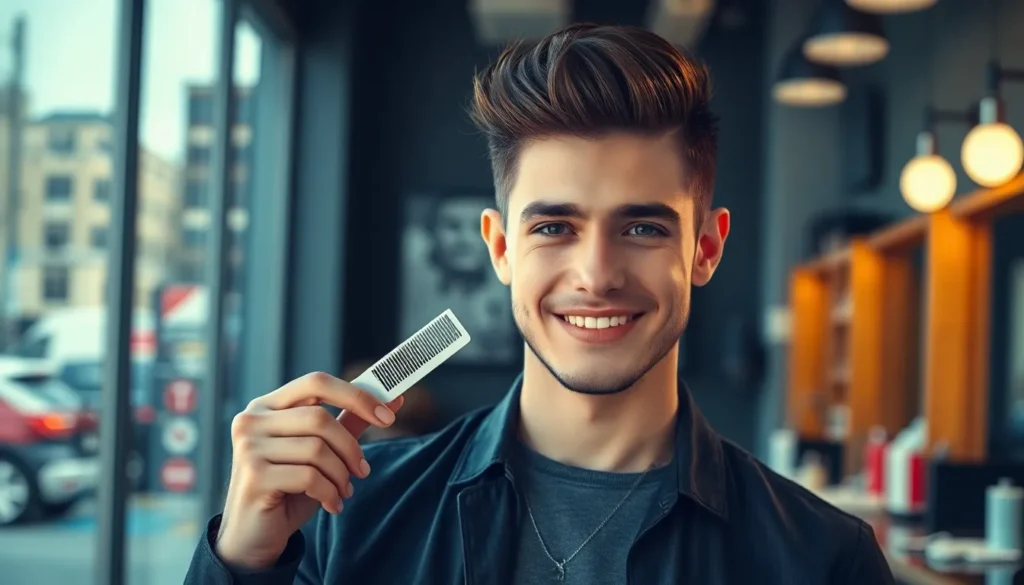We’re witnessing a major revival of one of the most iconic hairstyles from the 1960s – the mod haircut. This timeless look that once defined an entire cultural movement is making a powerful comeback in today’s barbershops and salons across America.
The mod haircut isn’t just another trendy style that’ll disappear next season. It’s a sophisticated blend of sharp lines clean cuts and effortless cool that works for virtually every face shape and hair type. Whether you’re heading to the boardroom or hitting the town this versatile cut delivers that perfect balance of professional polish and rebellious edge.
What makes the mod haircut so appealing to modern men is its low-maintenance nature and incredible adaptability. We’ll show you exactly why this classic style has stood the test of time and how you can customize it to match your personal aesthetic and lifestyle needs.
The Classic Mod Cut: Sharp and Structured
The quintessential mod haircut delivers precision with an unmistakable edge that defines masculine sophistication. We’ll explore the fundamental elements that make this style a barbershop staple.
Defining Features of the Traditional Mod Style
Clean tapered sides form the foundation of every authentic mod cut, typically featuring a number 2 or 3 guard fade that transitions smoothly into longer top sections. The sides maintain their structure through precise clipper work that eliminates bulk while preserving clean lines around the ears and neckline.
Medium length top hair ranges from 2 to 4 inches, providing enough volume for styling versatility without appearing overgrown. This length allows for the signature forward sweep that became synonymous with 1960s British youth culture and bands like The Beatles and The Kinks.
Sharp parting lines create visual separation between different hair sections, whether positioned on the left, right, or center of the head. Barbers achieve these crisp divisions using fine-tooth combs and precise scissor work that emphasizes geometric shapes.
Blunt cutting techniques produce the distinctive blocky silhouette that separates mod cuts from softer, layered styles. The hair ends receive straight cuts across rather than textured finishes, creating bold visual weight that frames facial features dramatically.
Minimal layering maintains the style’s structured appearance by avoiding excessive graduation throughout the cut. Most traditional mod styles feature only subtle internal layering to remove weight without compromising the overall geometric shape.
How to Ask Your Barber for a Classic Mod Cut
Request exact measurements when describing your desired mod cut to ensure clear communication about length preferences. Tell your barber “I want a classic mod cut with 3 inches on top, tapered to a number 2 on the sides” to establish concrete parameters for the haircut.
Show reference photos from the 1960s mod era or contemporary interpretations to provide visual context for your barber’s understanding. Images of iconic figures like Paul McCartney or modern adaptations help bridge any communication gaps about style expectations.
Specify the fade transition by indicating whether you prefer a high, mid, or low fade that connects the longer top section to shorter sides. Most classic mod cuts feature mid fades that begin around the temple area and blend seamlessly into the crown.
Mention your parting preference early in the consultation to help your barber plan the cut’s overall shape and direction. Whether you typically part your hair on the left side, right side, or prefer a center part affects how the barber approaches sectioning and cutting angles.
Discuss styling products you plan to use at home so your barber can adjust the cut to work with your preferred hair products. Pomades and styling creams require different cutting techniques than lighter products like texturizing sprays or matte clays.
Ask about maintenance schedules to understand how often you’ll need touch-ups to maintain the mod cut’s sharp appearance. Most barbers recommend returning every 3 to 4 weeks to preserve the style’s clean lines and proper proportions.
The Modern Mod: Updated Takes on Retro Style
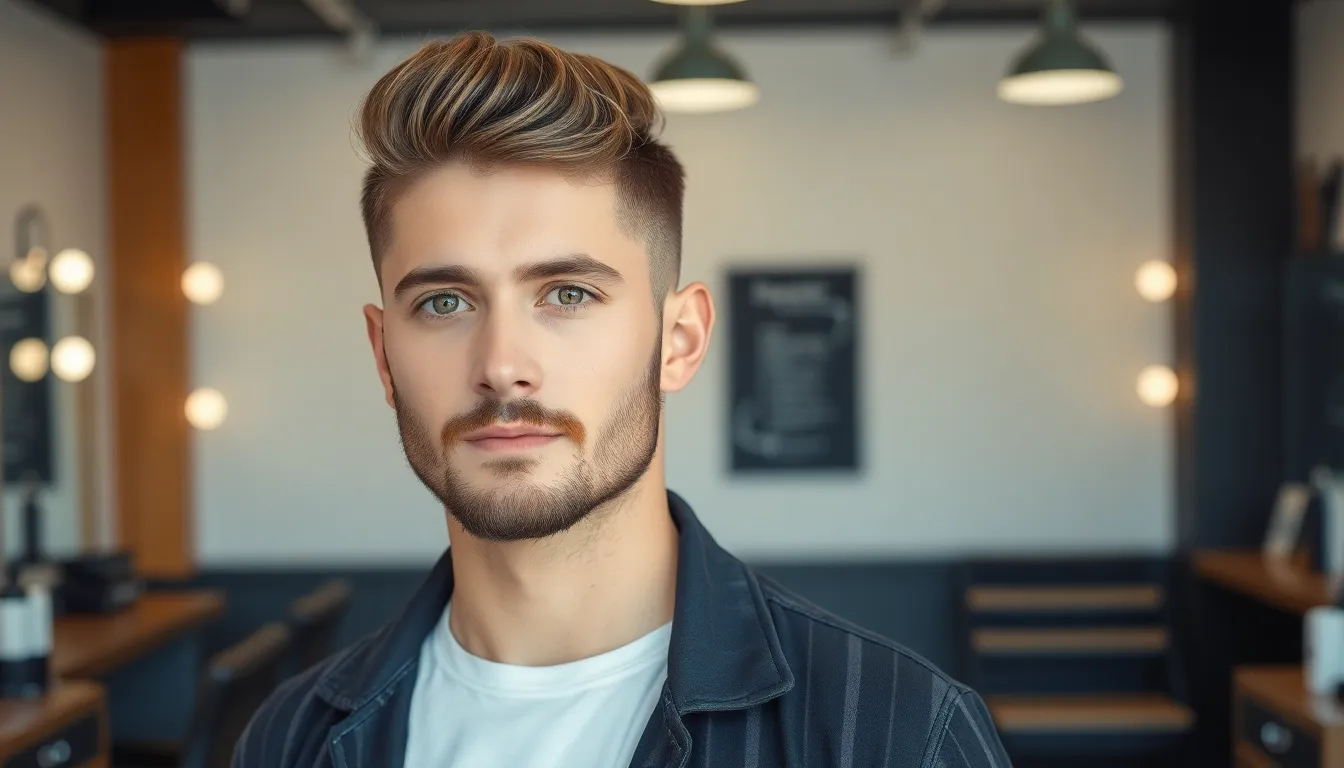
Today’s mod haircut embraces innovation while honoring its 1960s heritage. Modern barbers are reimagining this classic style with contemporary techniques that appeal to today’s fashion-conscious men.
Contemporary Variations and Styling Options
Textured Top Mod transforms the traditional flat appearance with subtle layering techniques. Barbers create movement within the longer top section while maintaining the signature clean sides. This variation works exceptionally well for men with naturally wavy or thick hair who want to embrace their texture.
Disconnected Mod features a more dramatic contrast between the sides and top portions. We see lengths ranging from 0.5 inches on the sides to 3-4 inches on top, creating a bold statement that suits oval and square face shapes. The sharp disconnection line replaces the gradual taper of classic versions.
Curly Mod Revival celebrates natural curl patterns within the structured framework. Modern stylists maintain the geometric parting while allowing controlled volume through the crown area. This approach requires specialized cutting techniques that work with curl direction rather than against it.
Asymmetrical Mod introduces off-center partings and varied lengths across the top section. One side might feature 2 inches while the other maintains 3.5 inches, creating visual interest that photographs well in professional settings.
Blending Vintage Elements with Current Trends
Fade Integration combines traditional mod structure with contemporary fade techniques. Skin fades, mid fades, and high fades replace the original blunt edges while preserving the overall silhouette. We recommend discussing fade heights with your barber to match your lifestyle and workplace requirements.
Product Evolution has revolutionized mod styling with modern pomades and clays. Water-based products offer the same hold as vintage options without the heaviness, making daily styling more manageable. Matte finish products create a contemporary look that photographs well under LED lighting.
Color Enhancement adds dimension through subtle highlighting or lowlighting techniques. Professional colorists can create depth within the top section while maintaining the clean lines that define mod cuts. Popular options include natural brown variations and strategic gray blending.
Beard Pairing represents a modern twist that original mods never considered. Today’s versions often incorporate well-groomed facial hair that complements rather than competes with the structured hairline. We suggest keeping beard lengths between 2-5mm to maintain the overall clean aesthetic.
Face Shape Compatibility for Mod Haircuts

Matching your mod haircut to your face shape maximizes the style’s visual impact while ensuring a flattering appearance. We’ve identified the most effective mod variations for different facial structures to help you achieve the perfect balance.
Best Mod Styles for Round Faces
Height-focused mod cuts work exceptionally well for round face shapes by creating vertical lines that elongate the appearance. We recommend keeping the top section between 3-4 inches long to add crucial height without overwhelming your features. Side-swept mod styles with deep parting lines create asymmetrical angles that break up the circular contours naturally.
Textured top variations offer another excellent option for round faces since the added volume draws attention upward. Keep the sides closely tapered to a #2 or #3 guard length to emphasize the contrast between top and sides. Angular parting techniques using precise razor lines add geometric structure that counters softer facial curves effectively.
Avoid blunt-cut mod styles that sit horizontally across the forehead as these emphasize width rather than length. Choose disconnected mod cuts where the top hair maintains 2-3 inches of length difference from the sides to create optimal proportions.
Ideal Cuts for Square and Angular Face Shapes
Softer mod interpretations complement square and angular face shapes by reducing harsh lines while maintaining the style’s essential character. We suggest incorporating subtle layering techniques in the top section to create gentle movement that softens strong jawlines. Medium-length mod cuts between 2-3 inches work particularly well since they don’t add excessive bulk to already prominent facial angles.
Textured fringe elements help balance strong foreheads and prominent cheekbones typical of angular face shapes. Request your barber to use point-cutting techniques on the front sections to create softer edges rather than blunt lines. Side-parted mod styles positioned slightly off-center work better than center parts which can emphasize facial symmetry too dramatically.
Curly mod variations are especially flattering for square faces since natural curl patterns introduce organic shapes that contrast beautifully with angular features. Keep the sides faded to a #1 or #2 length to prevent adding width while allowing the textured top to soften your overall appearance.
Essential Styling Products for Your Mod Haircut
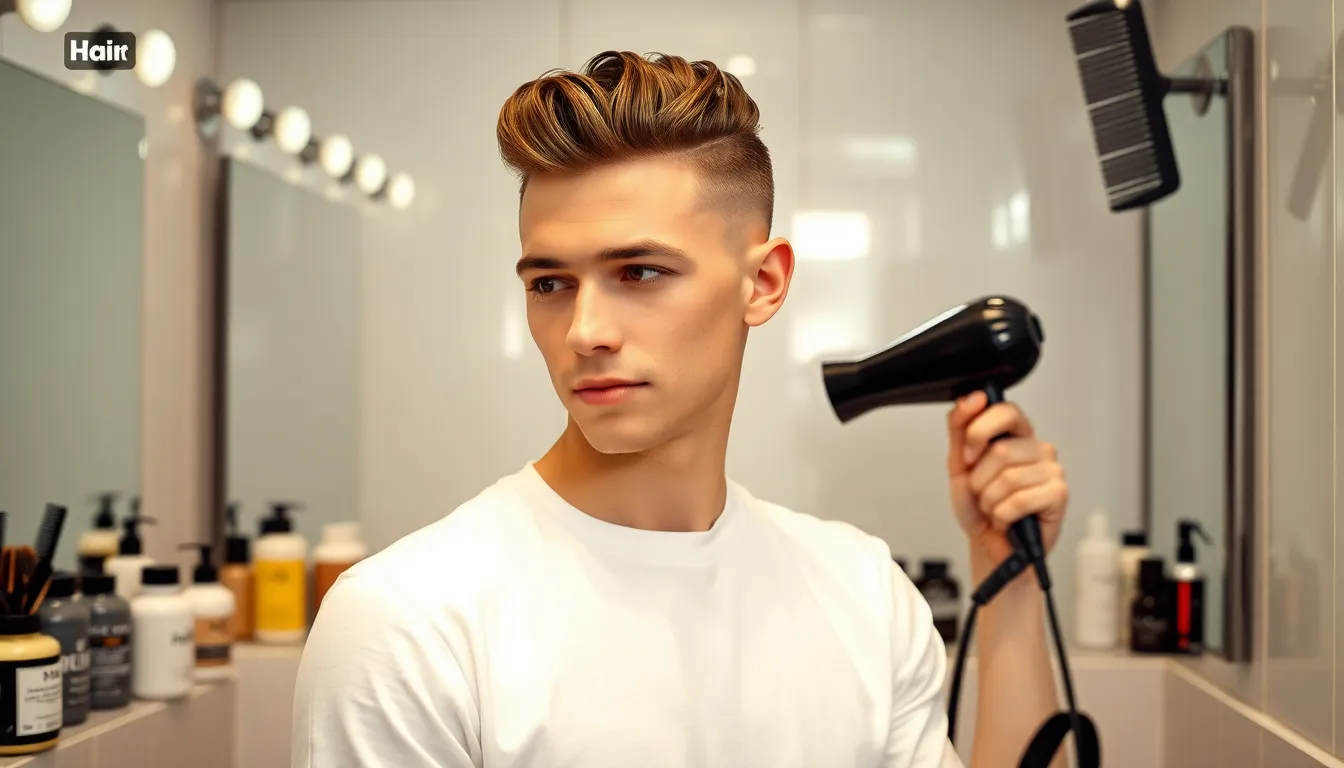
Achieving that perfect mod haircut look requires the right products and tools to maintain those sharp lines and structured silhouettes. We’ll guide you through the essential items every mod enthusiast should have in their grooming arsenal.
Pomades and Styling Creams for Hold
Water-based pomades deliver the classic mod shine while offering easy washout properties that traditional oil-based products lack. We recommend brands like Suavecito Original Hold or American Crew Pomade for their medium to strong hold capabilities that keep your mod cut looking sharp throughout the day.
Matte styling creams work exceptionally well for modern mod interpretations where you want structure without the traditional shine. Products like Hanz de Fuko Claymation or Baxter of California Clay Pomade provide excellent texture and hold while maintaining a natural finish that complements textured mod variations.
Strong hold gels remain essential for creating those precise parting lines that define the classic mod aesthetic. We suggest using alcohol-free formulas like DevaCurl Ultra Defining Gel or Aveda Confixor Liquid Gel to avoid drying out your hair while maintaining crisp edges.
Leave-in conditioners should be applied before styling products to protect your hair from daily manipulation and heat styling. Lightweight options like It’s a 10 Miracle Leave-In or Moroccan Oil Treatment create the perfect foundation for your styling routine without weighing down shorter mod cuts.
Tools You Need for Perfect Mod Hair
Fine-tooth combs are absolutely crucial for creating those signature sharp parts that make mod haircuts so distinctive. We recommend investing in quality options like Kent combs or Baxter of California combs that glide smoothly through product-laden hair without causing breakage.
Blow dryers with concentrator nozzles help you achieve the sleek, controlled finish that mod cuts demand. Professional models like the Dyson Supersonic or BaBylissPRO Nano Titanium offer precise airflow control that prevents frizz while creating smooth surfaces.
Round brushes in multiple sizes give you versatility when styling different sections of your mod cut. Small barrel brushes work perfectly for shorter sides, while medium barrels help create volume and direction in the longer top sections.
Hair clips and sectioning tools become invaluable when applying products evenly throughout your mod haircut. Professional sectioning clips allow you to work methodically through each area, ensuring consistent product distribution and styling precision.
Quality hair scissors deserve a place in your toolkit for maintaining those sharp edges between barber visits. We suggest leaving major cutting to professionals, but small touch-ups around the ears and neckline can extend the life of your mod cut significantly.
Daily Maintenance and Styling Routine
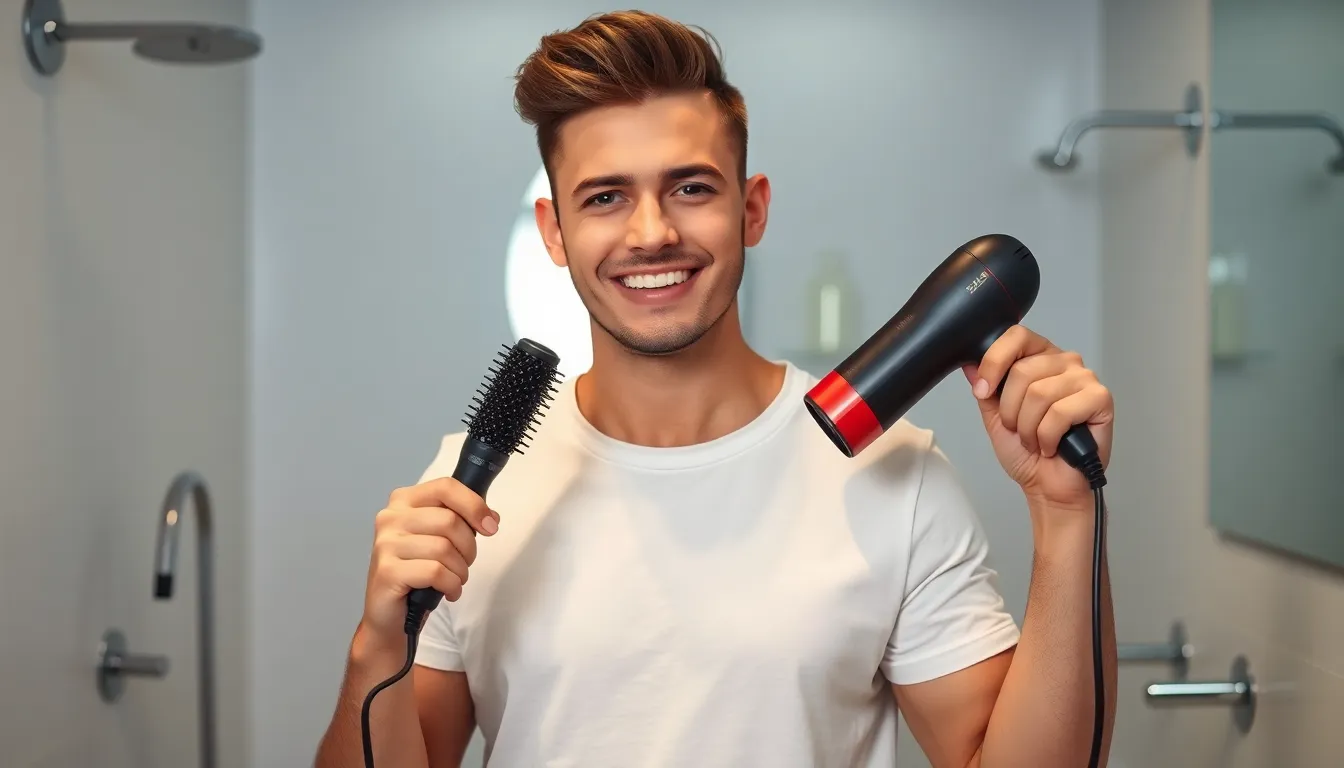
Maintaining your mod haircut’s sharp lines and structured silhouette requires a consistent daily approach that keeps the style looking fresh throughout the day.
Morning Styling Steps for the Perfect Look
Start with slightly damp hair from your morning shower or a light mist of water to activate your styling products effectively. We recommend towel drying until hair reaches about 60-70% dryness for optimal product absorption.
Apply your chosen pomade or styling cream while hair retains moisture, distributing 1-2 pumps evenly through the top section using your fingertips. Water-based pomades work particularly well for achieving that signature mod shine we discussed earlier.
Create your signature parting line using a fine-tooth comb, positioning it approximately 2-3 inches from your hairline for the most flattering angle. This sharp division becomes the foundation of your mod haircut’s distinctive structured appearance.
Blow dry your hair using a round brush to lift the top section while directing airflow downward on the sides. We suggest keeping heat on medium settings to prevent damage while maintaining your hair’s natural texture.
Set the style with a final light application of strong hold gel along the parting line, ensuring those crisp edges stay defined throughout your day. Focus on smoothing any flyaways that might disrupt the clean silhouette.
Finish with a quick brush through to eliminate any visible product buildup and create that polished, professional appearance that makes the mod haircut so versatile.
Touch-Up Tips Throughout the Day
Check your parting line around midday when natural oils begin affecting your hairstyle’s structure, using a pocket comb to redefine any blurred edges. This simple 30-second touch-up maintains the mod’s signature sharpness.
Carry a small amount of styling cream in a travel container for quick fixes, applying just a fingertip’s worth to smooth down any rebellious strands. We find this particularly useful during humid weather or windy conditions.
Use your fingers to gently lift and reshape the top section if it starts looking flat, working against your hair’s natural growth pattern to restore volume. This technique works especially well with textured mod variations.
Avoid over-combing your hair throughout the day, as excessive manipulation can break down your styling products and create an unnatural appearance. Instead, we recommend limiting touch-ups to 2-3 times maximum.
Keep blotting papers handy to remove excess oil from your scalp without disturbing your hairstyle’s structure, particularly important for men with naturally oily hair types. Press gently along the hairline where oil typically accumulates first.
End your day by loosely running your fingers through your hair to prevent product buildup from hardening overnight, which can make morning styling more difficult and damage your hair’s natural texture.
Professional Styling Tips from Expert Barbers
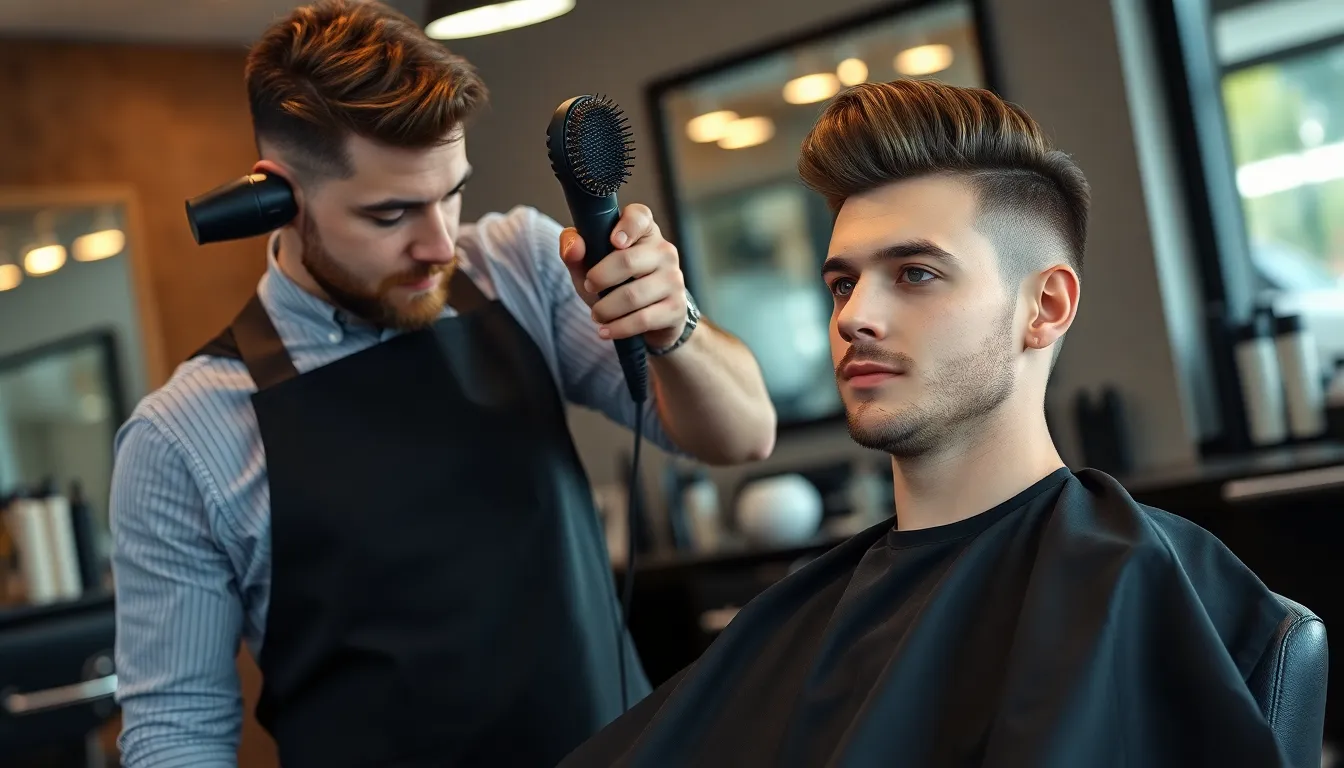
Expert barbers across America share insider techniques that transform a standard mod haircut into a perfectly styled masterpiece. We’ve gathered the most effective professional methods to help you achieve salon-quality results at home.
Techniques for Achieving the Right Volume
Start with towel-dried hair that retains about 30% moisture for optimal product application and heat styling. Professional barbers recommend this moisture level because completely dry hair resists styling products while overly wet hair dilutes their effectiveness.
Apply volumizing mousse to the roots using upward finger motions to create lift from the scalp. We suggest using a golf ball-sized amount for medium-length hair and working it through the crown area where volume matters most for the mod silhouette.
Use the blow dryer attachment with a concentrator nozzle to direct airflow upward at a 45-degree angle. Barbers consistently achieve better volume by lifting sections with a round brush while applying heat from below rather than above.
Employ the root lift technique by inserting the round brush underneath hair sections and pulling upward while blow-drying. This professional method creates lasting volume that supports the mod haircut’s structured top without requiring excessive product buildup.
Set the volume with cool air for 10-15 seconds after heat styling each section to lock in the lift. Temperature changes help hair cuticles close and maintain the desired shape throughout the day.
Finish with strategic teasing at the crown using a fine-tooth comb in gentle upward strokes. Professional stylists recommend limiting this technique to 2-3 passes to avoid damaging hair while achieving the authentic mod volume.
Common Mistakes to Avoid When Styling
Overloading hair with products ranks as the number one styling error that creates greasy buildup and weighs down the mod’s signature volume. We recommend starting with half the amount you think you need and adding more if necessary.
Styling completely wet hair prevents proper product adhesion and creates uneven distribution that leads to flat spots. Professional barbers emphasize that damp hair holds styles better and requires less product for desired results.
Brushing too aggressively breaks the mod’s clean lines and creates unwanted texture that contradicts the style’s structured appearance. Gentle combing motions preserve the haircut’s sharp edges while maintaining its polished finish.
Ignoring the natural growth pattern causes constant fighting against your hair’s tendencies and results in styles that don’t last. Expert barbers always work with natural cowlicks and growth directions to create sustainable looks.
Using the wrong brush size compromises volume creation and parting precision that define the mod aesthetic. Round brushes with 2-3 inch barrels work best for most mod variations while providing adequate lift without creating excessive curl.
Applying heat without protection damages hair cuticles and leads to dryness that makes styling increasingly difficult over time. Professional-grade heat protectants maintain hair health while ensuring consistent styling results.
Rushing the styling process results in uneven product distribution and asymmetrical volume that detracts from the mod’s balanced appearance. Taking 8-10 minutes for proper styling creates looks that last all day with minimal touch-ups.
Mod Haircut Variations by Hair Length

We’ve discovered that mod haircuts adapt beautifully to different hair lengths, offering flexibility while maintaining the style’s signature sharp lines. Each length variation brings unique styling possibilities and maintenance requirements to consider.
Short Mod Cuts for Low Maintenance
Textured crop variations deliver the mod aesthetic with minimal daily effort required. We recommend asking for 1-2 inches on top with heavily tapered sides that create sharp contrast against the fuller crown area. Styling takes just 3-5 minutes using a small amount of matte paste worked through damp hair.
Buzz cut mod adaptations feature ultra-short sides at grade 1-2 with slightly longer top sections reaching 0.5-1 inch in length. We find these cuts perfect for men with active lifestyles who still want sophisticated styling. The sharp parting line remains visible even at shorter lengths when properly executed by skilled barbers.
Short textured variations combine mod structure with modern movement using 1.5-2.5 inches of top length. We suggest these cuts for thick hair types that naturally hold shape without heavy products. Point cutting techniques add subtle texture while preserving the mod silhouette’s clean edges.
Medium Length Options for Versatility
Classic medium mod styles use 3-4 inches of top length for maximum styling flexibility throughout the week. We’ve found these lengths allow for both slicked-back formal looks and tousled casual appearances using the same base cut. Side parting placement becomes more prominent with increased length options.
Layered medium variations incorporate subtle graduation techniques while maintaining mod structure integrity. We recommend these cuts for men with fine to medium hair density who need additional volume support. The layers add movement without compromising the style’s signature blocky silhouette.
Disconnected medium styles feature dramatic length differences between top and side sections for bold contrast effects. We suggest 3.5-4.5 inches on top with skin fade sides to maximize the disconnected appearance. These cuts require precise blending at transition points to prevent harsh lines from appearing unintentional.
Swept variations use medium length tops styled forward or to the side for softer mod interpretations. We find these styles work exceptionally well for professional environments where subtle sophistication matters most. The forward sweep creates face-framing effects that complement various facial structures effectively.
Celebrity Inspiration: Famous Mod Haircuts
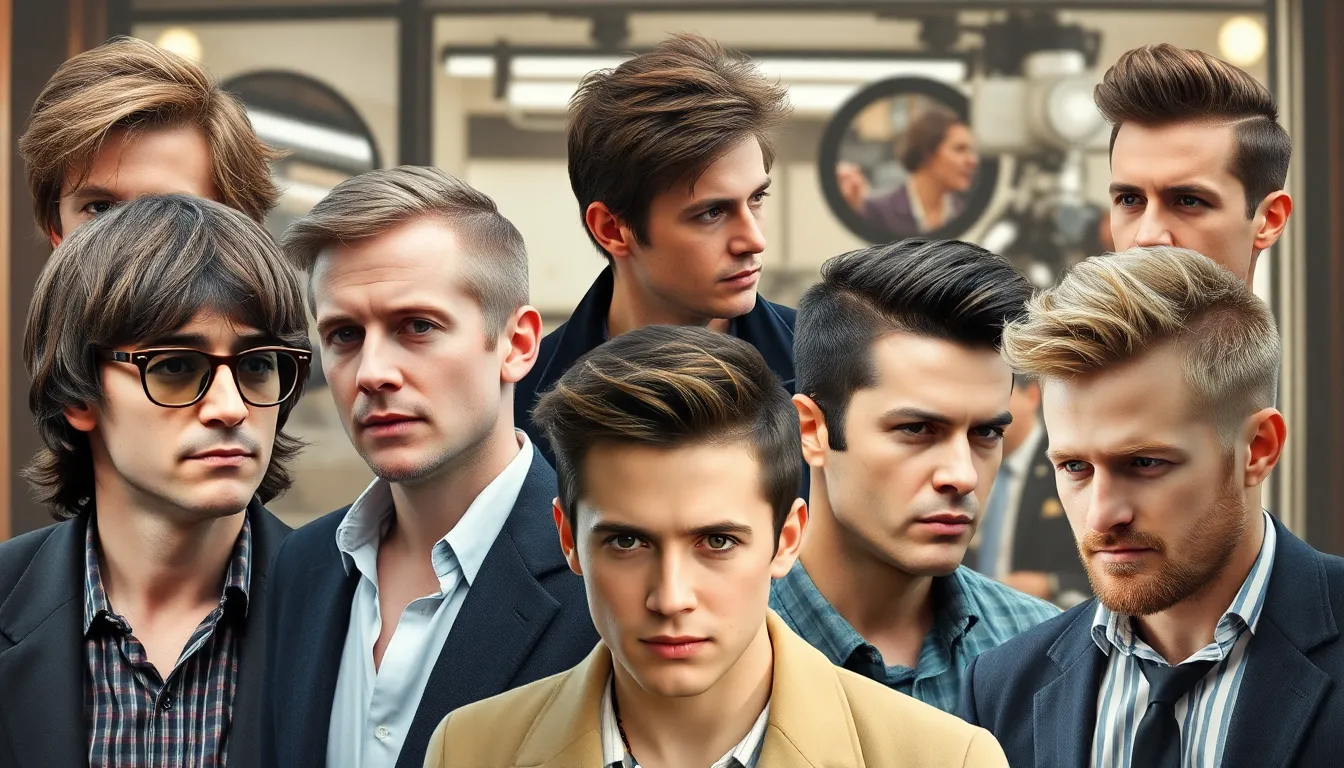
Celebrity mod haircuts continue to influence modern men’s hairstyles, bridging the gap between vintage sophistication and contemporary style. We’ve compiled the most influential mod looks from both the golden era and today’s trendsetting stars.
Iconic Mod Styles from the 1960s
The Beatles revolutionized men’s hairstyling with their signature bowl cuts that defined an entire generation. Paul McCartney’s precisely parted mod cut featured sharp edges and structured sides that became the template for countless barbershop requests. John Lennon’s slightly longer variation added subtle texture while maintaining the clean lines characteristic of authentic mod styling.
Mick Jagger popularized the shaggy mod interpretation that blended rebellious attitude with refined structure. His shoulder-length style incorporated the mod’s signature center parting while adding movement through strategic layering. The Rolling Stones frontman’s approach demonstrated how mod haircuts could adapt to different hair textures and personal aesthetics.
Michael Caine epitomized sophisticated mod styling in films like “Alfie” and “The Italian Job.” His perfectly coiffed side part featured immaculate tapering and geometric precision that showcased the haircut’s professional versatility. Caine’s styling approach emphasized the importance of daily grooming routines in maintaining mod haircuts’ structural integrity.
Twiggy’s pixie cut influenced male mod variations even though being primarily associated with women’s fashion. Her ultra-short style inspired men to experiment with cropped mod interpretations that maintained sharp edges while reducing styling time. This crossover appeal highlighted the mod haircut’s gender-neutral foundation and timeless geometric principles.
Modern Stars Rocking Updated Mod Cuts
Ryan Gosling showcases the textured mod revival with his contemporary take on classic proportions. His styling incorporates modern pomades and sea salt sprays to create natural movement while preserving the mod’s signature parting lines. Gosling’s approach proves that mod haircuts work exceptionally well for actors requiring versatile looks for different roles.
David Beckham experiments with disconnected mod variations that blend traditional elements with fade techniques. His recent appearances feature sharp contrast between longer top sections and closely cropped sides that update the classic silhouette. Beckham’s styling choices demonstrate how professional athletes can maintain mod haircuts even though active lifestyles.
Oscar Isaac brings curly texture to mod styling through carefully controlled shapes that honor the haircut’s geometric foundation. His approach uses leave-in conditioners and curl-defining creams to maintain structure while embracing natural hair patterns. Isaac’s interpretation shows how mod cuts adapt beautifully to different ethnic hair textures and curl patterns.
Timothée Chalamet popularizes the asymmetrical mod approach with subtle length variations that create visual interest. His red carpet appearances feature precisely placed partings and strategic layering that modernize traditional mod proportions. Chalamet’s styling proves that younger men can embrace mod haircuts while maintaining contemporary edge and sophistication.
Seasonal Adaptations of the Mod Style
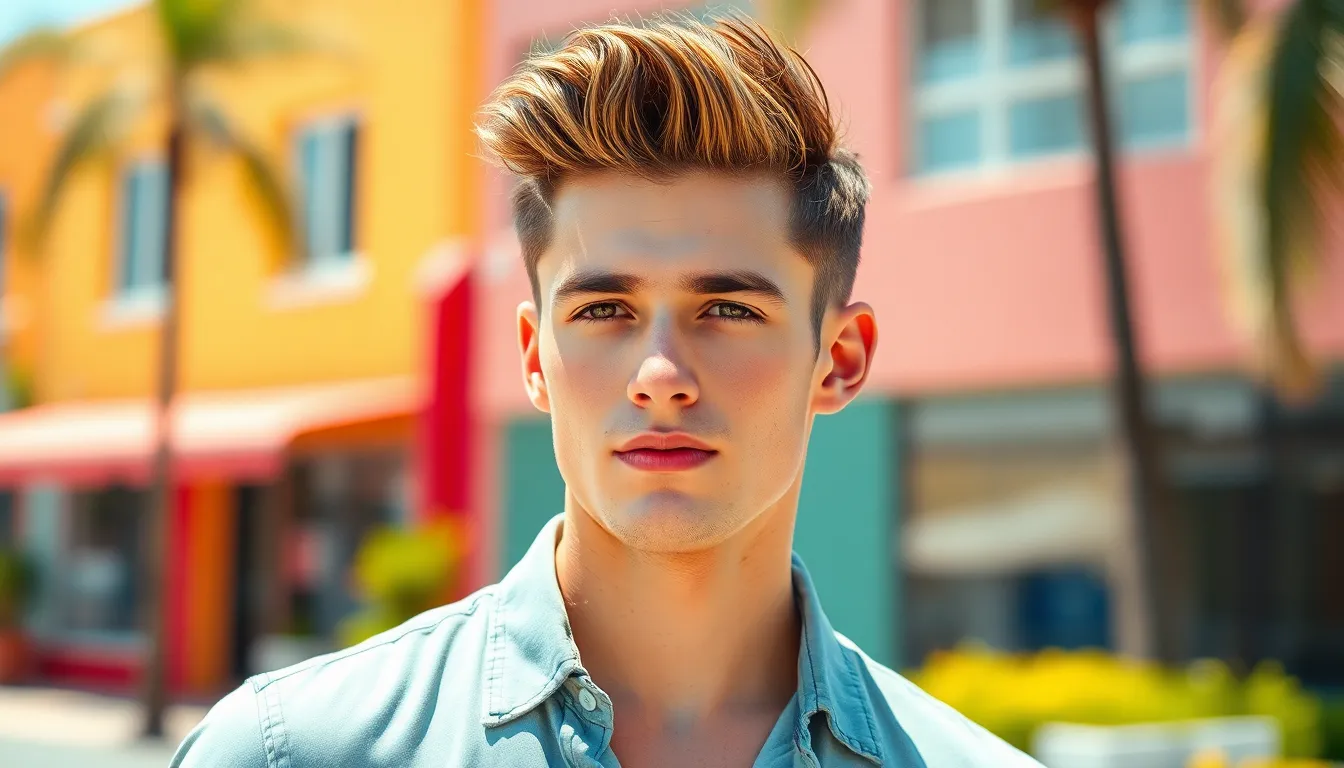
The mod haircut’s versatility extends beyond styling variations to seasonal adaptations that keep you looking sharp year-round. We’ll explore how to adjust this classic cut for different weather conditions while maintaining its signature structured appeal.
Summer-Friendly Mod Variations
Shorter mod cuts work exceptionally well during hot summer months when comfort becomes a priority. We recommend asking your barber for a tighter crop on the sides and back, reducing the overall length by about half an inch to improve airflow around your scalp.
Textured summer mods incorporate choppy layers throughout the top section to prevent hair from lying flat against your head in humid conditions. This variation maintains the mod’s clean parting line while adding movement that looks effortless even when you’re sweating.
Disconnected summer styles feature an even sharper contrast between the ultra-short sides (often a #2 guard or shorter) and the medium-length top. This dramatic difference creates cooling ventilation while preserving the mod’s distinctive silhouette.
Lightweight styling products become essential during warmer months when heavy pomades can feel uncomfortable. We suggest switching to water-based styling creams or sea salt sprays that provide hold without weighing down your hair or creating a greasy appearance.
Winter Styling Adjustments and Tips
Longer mod variations work better in colder months when you need extra coverage and warmth. We recommend growing out the top section to 3-4 inches while keeping the sides neatly trimmed to maintain the style’s structured foundation.
Moisturizing treatments become crucial during winter when indoor heating and cold outdoor air can dry out your scalp and hair. Apply leave-in conditioners twice weekly and use hydrating hair masks to prevent flakiness and maintain shine.
Heavier styling products perform better in cold, dry conditions when your hair needs extra hold and moisture. Switch to oil-based pomades or styling balms that provide stronger control while protecting your hair from harsh winter elements.
Static control techniques help manage flyaway hairs that commonly occur during winter months. We suggest using anti-static sprays or lightly misting your brush with water before styling to smooth down rebellious strands.
Hat-friendly adjustments ensure your mod cut looks polished even after wearing winter headwear. Ask your barber to trim the sides slightly shorter and create a more flexible parting line that can be easily restored after removing hats or beanies.
Conclusion
The mod haircut’s enduring appeal lies in its remarkable ability to adapt while maintaining its distinctive character. Whether you’re drawn to the classic clean lines or prefer contemporary variations with fades and texture we’ve shown how this versatile style works for virtually every man.
What sets the mod apart isn’t just its striking appearance—it’s the confidence it instills. From celebrity red carpets to everyday barbershops this haircut continues proving that timeless style never goes out of fashion.
With the right products techniques and maintenance routine you can master this iconic look at home. The mod haircut remains one of the most reliable choices for men who want sophistication without sacrificing personality.
Frequently Asked Questions
What is a mod haircut and what makes it unique?
A mod haircut is a classic 1960s hairstyle featuring clean tapered sides, medium-length top hair, and sharp parting lines. It’s distinguished by its structured appearance created through blunt cutting techniques and minimal layering, resulting in a distinctive blocky silhouette that balances sophistication with rebellious edge.
How do I ask my barber for a mod haircut?
Be specific about length preferences and show reference photos of the desired style. Discuss fade transitions, parting preferences, and mention you want clean, sharp lines. Ask about styling products and maintenance schedules to ensure your barber understands you want the classic structured mod appearance.
What face shapes work best with mod haircuts?
Mod haircuts are versatile and can be adapted for various face shapes. The key is customizing the cut’s proportions and parting to enhance your facial structure. Your barber can adjust the length, fade height, and styling direction to create a flattering appearance regardless of face shape.
What products do I need to style a mod haircut?
Essential products include water-based pomades for shine and hold, matte styling creams for texture, strong hold gels for structure, and leave-in conditioners for hair health. You’ll also need a fine-tooth comb, blow dryer, and round brush for proper styling and maintenance.
How do I maintain my mod haircut daily?
Start with slightly damp hair, apply your chosen styling product, create a sharp parting line, and blow-dry for volume. Throughout the day, check your parting line, use travel-sized styling cream for touch-ups, and manage excess oil with blotting papers while handling gently.
Are there modern variations of the classic mod haircut?
Yes, contemporary interpretations include the Textured Top Mod, Disconnected Mod, Curly Mod Revival, and Asymmetrical Mod. These variations incorporate modern fade techniques, updated styling products, color enhancements, and can be paired with well-groomed facial hair for a fresh take.
How does hair length affect the mod haircut style?
Short mod cuts offer low maintenance with textured crops and buzz variations. Medium-length options provide versatility for both formal and casual looks, featuring layered or disconnected styles. Each length maintains the mod’s signature sharp lines while adapting to different styling preferences and lifestyles.
How do I adapt my mod haircut for different seasons?
For summer, choose shorter cuts with textured layers and lightweight products to combat humidity. In winter, opt for longer variations with moisturizing treatments and heavier styling products. Always protect against static and maintain polish even when wearing hats throughout seasonal changes.

